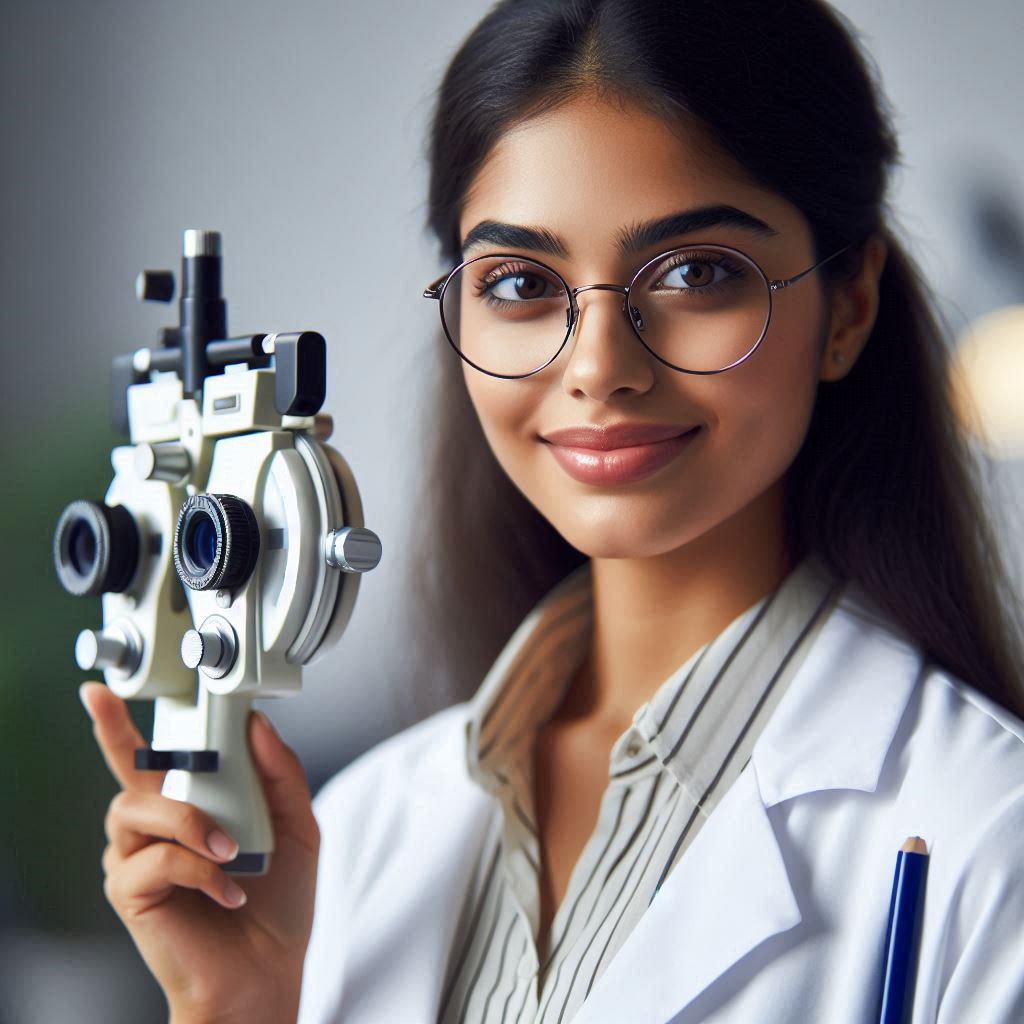Introduction
Optometry is an ever-evolving field, with new technologies constantly being developed to improve eye care.
It’s essential for patients to stay informed about these advancements to make educated decisions regarding their eye health.
Importance of Staying Informed
One of the key reasons patients should stay informed about the latest technologies in optometry is the potential to receive more efficient and accurate diagnoses.
Advancements in imaging technologies, such as optical coherence tomography (OCT) and wavefront technology, allow optometrists to visualize and analyze the eye’s structures in greater detail than ever before.
This leads to earlier detection of eye conditions and more precise treatment plans.
Furthermore, staying informed about the latest technologies in optometry can also lead to a better patient experience.
For example, advancements in contact lens technology, such as silicone hydrogel lenses and custom-made scleral lenses, can provide patients with greater comfort, convenience, and improved vision correction.
Patients who are aware of these options can work with their optometrist to find the best solution for their individual needs.
In essence, staying informed about the latest technologies in optometry is crucial for patients to receive the best possible eye care.
By being aware of advancements in diagnostic tools, treatment options, and vision correction technologies, patients can take an active role in their eye health and work with their optometrist to achieve optimal outcomes.
Overview of Traditional Optometry Practices
Common tools and techniques used by optometrists in the past
In the past, optometrists relied on various tools and techniques to assess and improve vision.
Common tools included the Snellen chart for visual acuity testing and ophthalmoscopes to examine the eye.
Optometrists also used trial frames for prescribing corrective lenses based on subjective refraction tests.
Limitations of Traditional Optometry Practices
- Subjective refraction tests may lead to inaccurate prescriptions.
- Traditional tools may not provide a comprehensive assessment of eye health.
- Limitations in detecting early signs of eye diseases or conditions.
- Manual methods can be time-consuming and may result in errors.
- Patients may experience discomfort during subjective refraction tests.
- Limited options for customized vision correction solutions.
- Difficulty in predicting possible changes in vision over time.
- Lack of integration with digital technologies for enhanced patient care.
Overall, while traditional optometry practices have been effective to a certain extent, advancements in technology have revolutionized the field and have addressed many of these limitations.
Let’s delve into some of the latest technologies in optometry that patients should be aware of.
Read: Understanding Vision Tests and Eye Exams by Optometrists
Introduction to new technologies in optometry
Over the past few years, the field of optometry has seen significant advancements.
These new technologies play a crucial role in improving the diagnosis and treatment of various eye conditions.
Advancements in Optometry
Optical Coherence Tomography (OCT)
OCT is a non-invasive imaging technique that provides detailed cross-section images of the eye.
It allows optometrists to visualize the retina, optic nerve, and other structures with high resolution.
Transform Your Career Today
Unlock a personalized career strategy that drives real results. Get tailored advice and a roadmap designed just for you.
Start NowOCT is particularly useful in detecting conditions like glaucoma, diabetic retinopathy, and macular degeneration.
Wavefront Technology
Wavefront technology measures how light travels through the eye and detects abnormalities in its path.
This technology helps in identifying higher-order aberrations that may impact vision quality.
By capturing a more detailed view of the eye’s optical system, wavefront technology enables precise correction with custom contact lenses or LASIK surgery.
Automated Refraction Systems
Automated refraction systems use advanced algorithms to determine the most accurate prescription for corrective lenses.
These systems eliminate the need for manual adjustment of lenses, resulting in faster and more accurate outcomes.
Patients experience improved comfort during the refraction process, leading to enhanced overall satisfaction with their vision correction.
3D Biometry
3D biometry provides precise measurements of the eye’s structure for intraocular lens calculations before cataract surgery.
This technology uses advanced imaging techniques to gather data on the cornea, lens, and anterior chamber.
By incorporating 3D biometry into surgical planning, optometrists can achieve better post-operative outcomes and increased patient satisfaction.
Telemedicine and Remote Eye Care
Telemedicine allows patients to receive eye care services remotely through virtual consultations.
Optometrists can monitor patients’ eye health, provide prescriptions, and offer guidance on managing eye conditions from a distance.
Remote monitoring technology also enables early detection of changes in eye health, promoting timely interventions and improved outcomes.
Impact of New Technologies on Optometry
- These advancements enhance the accuracy and efficiency of eye exams.
- Optometrists can now detect and treat eye conditions earlier, preventing irreversible vision loss.
- Patients benefit from personalized treatment plans and improved overall eye health outcomes.
- The integration of new technologies in optometry ensures a higher standard of care and patient satisfaction.
Read: How to Choose the Right Optometrist for Your Needs
Advanced diagnostic tools
Benefits of Digital Retinal Imaging
Digital retinal imaging is a cutting-edge technology that allows optometrists to capture high-resolution images of the retina.
These images provide detailed information about the health of the retina, optic nerve, and blood vessels in the eye.
This technology is non-invasive and allows for quick and painless imaging of the eye.
Benefits of Optical Coherence Tomography
Optical coherence tomography (OCT) is another advanced diagnostic tool that is commonly used in optometry.
OCT uses light waves to create detailed cross-sectional images of the retina.
Showcase Your Business Today
Reach thousands of readers actively exploring professional services. Publish your business profile and grow your audience now.
Publish NowThis technology helps optometrists detect and diagnose various eye conditions, such as macular degeneration, glaucoma, and diabetic retinopathy.
OCT is especially useful for monitoring the progression of these diseases and evaluating the effectiveness of treatment.
Early Detection of Eye Diseases
Both digital retinal imaging and optical coherence tomography play a crucial role in the early detection of eye diseases.
By providing detailed images of the structures within the eye, these tools allow optometrists to identify signs of eye conditions before symptoms occur.
Early detection is key in preventing vision loss and maintaining overall eye health.
With the help of these advanced diagnostic tools, optometrists can provide timely treatment and management strategies to preserve vision and enhance quality of life for their patients.
Read: Common Eye Conditions Treated by Optometrists

Innovative treatment options
Wavefront-guided LASIK
Wavefront-guided LASIK is a cutting-edge technology that allows for a more personalized treatment approach for patients.
Traditional LASIK procedures involve reshaping the cornea based on the patient’s glasses prescription, but wavefront-guided LASIK goes a step further by mapping the unique imperfections in the individual’s eye.
This detailed mapping provides a custom treatment plan that can address not only nearsightedness, farsightedness, and astigmatism but also higher-order aberrations that can impact visual quality.
By precisely targeting these aberrations, wavefront-guided LASIK can result in sharper vision and reduced glare and halos at night, offering patients a higher likelihood of achieving 20/20 vision or better.
Orthokeratology
Orthokeratology, also known as ortho-k, is another innovative treatment option that offers a non-surgical alternative to correct refractive errors.
This technique involves wearing specially designed gas-permeable contact lenses overnight to reshape the cornea temporarily.
Patients then remove the lenses in the morning and enjoy clear vision throughout the day without the need for glasses or daytime contact lenses.
Orthokeratology is particularly effective for patients with mild to moderate nearsightedness and can slow down the progression of myopia in children.
It is a safe and reversible procedure that can provide freedom from corrective eyewear during waking hours.
Both wavefront-guided LASIK and orthokeratology present exciting opportunities for patients seeking customized and effective solutions for their vision correction needs.
By staying informed about the latest technologies in optometry, patients can make empowered decisions about their eye care and explore treatment options that best suit their individual needs and lifestyle.
Read: Optometrist vs. Ophthalmologist: Key Differences Explained
Virtual reality in vision therapy
How virtual reality is being used to enhance vision therapy exercises
Virtual reality enhances vision therapy exercises by creating immersive environments.
It provides a fun and engaging way for patients to work on their visual skills.
VR can simulate real-life scenarios to help patients practice and improve their vision.
The technology allows for personalized and adaptive vision rehabilitation programs.
Benefits of incorporating virtual reality in vision rehabilitation programs
- Improved patient engagement and motivation during therapy sessions.
- Enhanced visual perception and spatial awareness through interactive exercises.
- Real-time feedback on progress and performance for both patients and therapists.
- Customizable treatment plans based on individual needs and goals.
- Increased efficiency in delivering vision therapy treatments.
Overall, virtual reality is revolutionizing vision therapy by making it more interactive, engaging, and effective for patients.
By incorporating this technology into rehabilitation programs, patients can experience enhanced outcomes and faster progress in improving their vision.
Uncover the Details: History and Evolution of the Respiratory Therapy Profession
Remote monitoring and telemedicine
Remote monitoring and telemedicine are transforming the field of optometry by offering innovative ways for optometrists to interact with patients and manage chronic eye conditions.
Telemedicine Revolutionizing Optometry
Telemedicine utilizes digital communication tools to connect optometrists with patients remotely, making it convenient and efficient for both parties.
This technology allows patients to consult with optometrists from the comfort of their homes, eliminating the need for in-person visits.
With telemedicine, patients can receive timely and expert advice on their eye health concerns without having to travel to a clinic or office.
This ease of access ensures that patients can seek help whenever they need it, leading to early detection and treatment of eye conditions.
Benefits of Remote Monitoring
Remote monitoring is particularly beneficial for managing chronic eye conditions such as glaucoma, diabetic retinopathy, and age-related macular degeneration.
By using remote monitoring devices, optometrists can track changes in the patient’s eye health over time and adjust treatment plans accordingly.
- Early Detection: Remote monitoring allows optometrists to detect changes in the patient’s eye health early, preventing complications and preserving vision.
- Convenience: Patients can monitor their eye health from home, eliminating the need for frequent clinic visits and reducing travel time and expenses.
- Personalized Care: Optometrists can tailor treatment plans based on real-time data collected through remote monitoring devices, improving the overall quality of care.
- Improved Outcomes: By monitoring chronic eye conditions closely, optometrists can intervene promptly and prevent the progression of the disease, leading to better outcomes for patients.
- Patient Engagement: Remote monitoring devices empower patients to take an active role in managing their eye health, promoting better compliance with treatment plans and healthier lifestyle choices.
In general, remote monitoring and telemedicine are revolutionizing the field of optometry by enhancing patient access to care, improving outcomes for chronic eye conditions, and promoting patient engagement in their eye health management.
These technologies represent the future of optometric practice, offering new avenues for delivering high-quality and personalized care to patients.
As these technologies continue to evolve, optometrists must stay informed and embrace these innovations to provide the best possible care for their patients.
Uncover the Details: Orthopedic Technologist: Professional Associations
Explore Further: How Registered Dietitians Use Data to Improve Health
Future trends in optometry technology
Advancements in Optometry Technology
Optometry technology is constantly evolving to provide better care for patients. In the near future, we can expect to see significant advancements that will revolutionize how eye care is delivered.
These advancements include:
Showcase Your Business Today
Reach thousands of readers actively exploring professional services. Publish your business profile and grow your audience now.
Publish NowTelemedicine
Telemedicine in optometry involves using digital communication tools to provide remote eye care services.
Patients can consult with optometrists through video calls, receive prescriptions, and even monitor their eye health from the comfort of their homes.
This technology reduces the need for in-person visits and improves accessibility to eye care services.
Artificial Intelligence
Artificial intelligence (AI) is being integrated into optometry tools to enhance diagnostic capabilities and personalize treatment plans.
AI algorithms can analyze retinal images, detect early signs of eye diseases, and improve the accuracy of prescriptions.
By harnessing the power of AI, optometrists can offer more precise and effective care to their patients.
Virtual Reality Training
Virtual reality (VR) technology is increasingly used in optometry education and training.
Optometry students and practicing professionals can simulate real-life scenarios, practice surgical procedures, and improve their diagnostic skills in a virtual environment.
VR training enhances learning outcomes and ensures that optometrists are well-prepared to address complex eye conditions.
Importance of Embracing New Technologies
It is crucial for patients to stay informed about the latest advancements in optometry technology and be open to embracing these new tools for better eye care.
By embracing new technologies, patients can experience the following benefits:
Improved Diagnosis and Treatment
New technologies in optometry enhance the accuracy of diagnosis and treatment.
By utilizing advanced tools, optometrists can detect eye conditions at an early stage, customize treatment plans, and monitor progress more effectively.
Patients can benefit from timely interventions and improved outcomes for their eye health.
Enhanced Patient Experience
Incorporating new technologies into eye care services enhances the overall patient experience.
Telemedicine enables patients to receive timely consultations without the need for travel, reducing waiting times and increasing convenience.
AI-powered tools streamline the diagnostic process, leading to quicker assessments and more personalized care.
Patients can access comprehensive eye care services in a more efficient and patient-centered manner.
Accessibility and Affordability
New optometry technologies improve accessibility to eye care services, particularly for individuals in remote or underserved areas.
Telemedicine eliminates geographical barriers and enables patients to seek expert advice without traveling long distances.
Additionally, these technologies can lower the costs associated with eye care, making it more affordable and accessible to a wider population.
By embracing the future trends in optometry technology, patients can empower themselves to proactively manage their eye health and receive high-quality care.
Staying informed about these advancements and collaborating with optometrists who leverage cutting-edge technologies will lead to better eye health outcomes and improved overall well-being.
See Related Content: How Rehabilitation Counseling Supports Recovery
Conclusion
Staying informed about the latest technologies in optometry benefits patients greatly.
We discussed several advancements, including digital retinal imaging, optical coherence tomography, and wavefront technology.
These technologies enhance diagnostic accuracy, allowing for early detection and treatment of eye conditions.
Improved treatment options like customized contact lenses and advanced LASIK procedures provide better outcomes.
Tele-optometry expands access to eye care, making it convenient and efficient for patients.
Discuss these advancements with your optometrist during your next visit.
Understanding how these technologies apply to your specific needs ensures personalized care.
Your optometrist can explain how digital retinal imaging monitors your eye health over time.
They can demonstrate how optical coherence tomography provides detailed images of your eye’s internal structures.
They can also discuss how wavefront technology can improve your vision correction.
By engaging in these conversations, you become an active participant in your eye care.
This collaboration helps in creating a tailored treatment plan that suits your lifestyle and health needs. Don’t hesitate to ask questions and express any concerns.
Your optometrist’s expertise combined with these technological advancements can significantly improve your eye health and vision quality.
Embrace these innovations and ensure you receive the most advanced and personalized care available.
Stay proactive about your eye health and take advantage of these technological advancements to maintain optimal vision and eye health.
[E-Books for Sale]
The Big Book of 500 High-Paying Jobs in America: Unlock Your Earning Potential
$19.99 • 500 High-Paying Jobs • 330 pages
Explore 500 high-paying jobs in America and learn how to boost your career, earn more, and achieve success!
See All 500 High-Paying Jobs of this E-Book
1001 Professions Without a Degree: High-Paying American Jobs You Can Start Now
$19.99 • 1001 Professions Without a Degree • 174 pages
Discover 1001 high-paying jobs without a degree! Unlock career tips, skills, and success strategies for just $19.99!




